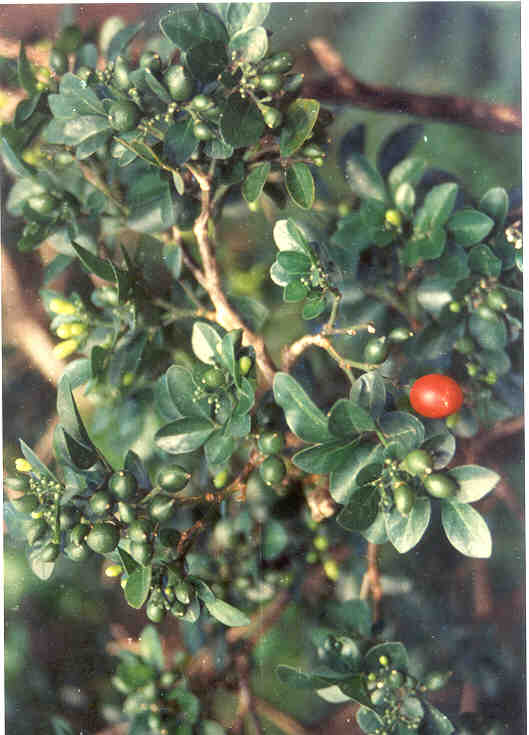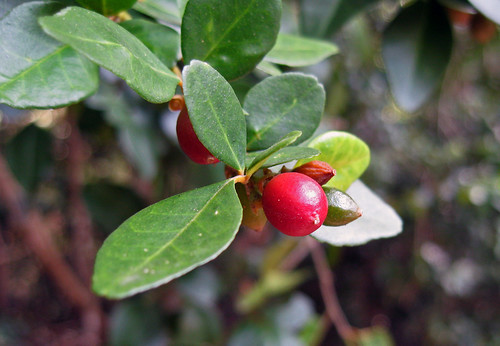Triphasia trifolia (syn. Limonia trifolia Burm. f., Triphasia aurantiola Lour.; also called limeberry, lime berry, or limoncito) is a species of Triphasia in the family Rutaceae, native to tropical southeastern Asia in Malaysia and possibly elsewhere.

It is an evergreen shrub (rarely a small tree) growing to 3 m tall. The leaves are trifoliate, glossy dark green, each leaflet 2-4 cm long and 1.5-2 cm broad. The flowers are white, with three petals 10-13 mm long and 4 mm broad. The fruit is a red, edible hesperidium 10-15 mm diameter, similar to a small Citrus fruit.
Cultivation and uses
It is grown for its edible fruit, and has been widely introduced to other subtropical to tropical regions of the world; it has become naturalized on a number of islands in the tropical Pacific Ocean. The Limeberry has been used as a bonsai plant.
This tree is also considered a weed in other introduced locations.
| Common name: | Lime berry | Family: | Rutaceae |
| Author: | (Burm. f.) P. Wils. | Botanical references: | 200 |
| Synonyms: | Triphasia aurantiola (Lour.), Limonia trifolia | ||
| Known Hazards: | None known | ||
| Range: | E. Asia - China. | ||
| Habitat: | Arid ground[245]. | ||
| Plants For A Future Rating (1-5): | 2 | ||
| Other Possible Synonyms: | From various places across the web, may not be correct. See below. | ||
| Limonia trifoliata[G] T. trifoliata[G,P] | |||
| Other Common Names: | From various places around the Web, may not be correct. See below. | ||
| Jeruk Kingkip [E], Limau Keresek [E], Limau Kiah [E], Limau Kikir [E], Limeberry [B,P], Orange Berry [E], | |||
| Epithets: | From a Dictionary of Botanical Epithets | ||
| trifolia = 3 leaves; | |||
| Other Range Info: | From the Ethnobotany Database | ||
| Guam; Java | |||
Physical Characteristics
An evergreen shrub growing to 3m. It is hardy to zone 10. It is in leaf all year. The scented flowers are hermaphrodite (have both male and female organs). We rate it 2 out of 5 for usefulness.

The plant prefers light (sandy), medium (loamy) and heavy (clay) soils and requires well-drained soil. The plant prefers acid, neutral and basic (alkaline) soils. It cannot grow in the shade. It requires dry or moist soil.
Habitats and Possible Locations


Edible Uses
Fruit - raw or cooked. Red and fleshy[1], the fully ripe fruit has an agreeable sweet taste. Aromatic, juicy and somewhat mucilaginous, the fruit can also be pickled or made into jams etc. The fruit is about 15mm in diameter.
Medicinal Uses
Skin.
The leaves are applied to the body in the treatment of diarrhoea, colic and skin diseases.
Other Uses
The leaves are used as an aromatic bath. The leaves are used as cosmetics.
A gum runs from the stem, though the report does not mention any uses for this gum.
Cultivation details
Most reports say that this species is not hardy in Britain, requiring greenhouse protection, but one report says that a plant outdoors at Boslewick in Cornwall produces fruit.
Plants are sometimes cultivated for their edible fruit.

All parts of the plant are aromatic. The white flowers have a scent of orange blossom. The leaves are covered in pellucid dots and release a resinous scent when bruised. The fruits are lemon-scented.
Propagation


Scent
- Fruit: Crushed
- The berries are lemon-scented.
- Flowers: Fresh
- The white flowers have a scent of orange blossom.
- Leaves: Crushed
- The leaves are covered in pellucid dots and release a resinous scent when bruised.
| Triphasia trifolia | ||||||||||||||||
|---|---|---|---|---|---|---|---|---|---|---|---|---|---|---|---|---|
 Foliage and fruit | ||||||||||||||||
| Scientific classification | ||||||||||||||||
| ||||||||||||||||
| Binomial name | ||||||||||||||||
| Triphasia trifolia |


No comments:
Post a Comment